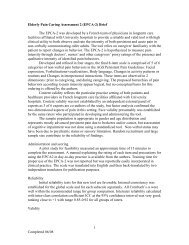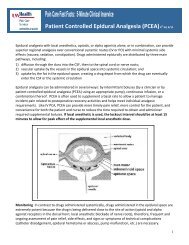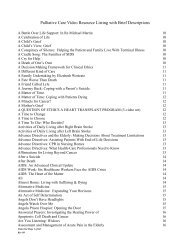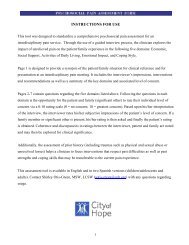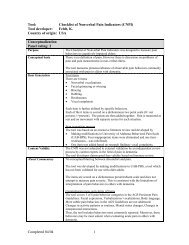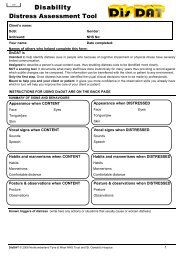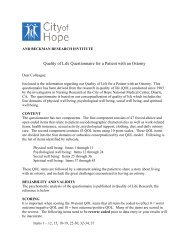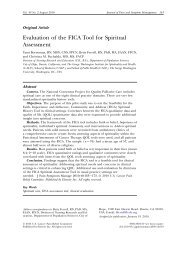Pain Assessment in Advanced Dementia - Pain Resource Center
Pain Assessment in Advanced Dementia - Pain Resource Center
Pain Assessment in Advanced Dementia - Pain Resource Center
You also want an ePaper? Increase the reach of your titles
YUMPU automatically turns print PDFs into web optimized ePapers that Google loves.
presence of pa<strong>in</strong>.Scor<strong>in</strong>g of the breath<strong>in</strong>g <strong>in</strong>dicator seems unrelated to pa<strong>in</strong> severity.Breath<strong>in</strong>g does not seem to be a key <strong>in</strong>dicator of pa<strong>in</strong>. However, the tooldevelopers argue that one of the known areas believed to cause negativefeel<strong>in</strong>gs for persons with dementia is the aversive symptoms associated with<strong>in</strong>tercurrent respiratory <strong>in</strong>fections and that pneumonia is a the proximal causeof death for many demented persons. Thus, they <strong>in</strong>cluded the breath<strong>in</strong>g item.We perceive consolablity as a response to an <strong>in</strong>tervention, not a behavioralmanifestation of pa<strong>in</strong>. However, the relationship between consolability andpa<strong>in</strong> may be an area for future research <strong>in</strong> this population.The validity for the scor<strong>in</strong>g of items accord<strong>in</strong>g to pa<strong>in</strong> severity or separationof behaviors with<strong>in</strong> each major category is not established, (eg. Breath<strong>in</strong>g isscored: Normal=0, Occasional labored breath<strong>in</strong>g/Short period ofhyperventilation =1, Noisy labored breath<strong>in</strong>g/Long period ofhyperventilation/Cheyne-Stokes respirations=2). However the tool appears toidentify higher and lower levels of pa<strong>in</strong> <strong>in</strong> an <strong>in</strong>dividual.Although the PAINAD does not adequately sample the content area ofbehavioral <strong>in</strong>dicators for pa<strong>in</strong> <strong>in</strong> elders with dementia who are unable tocommunicate, studies have demonstrated that the tool measures pa<strong>in</strong>. It maynot detect pa<strong>in</strong> <strong>in</strong> patients that demonstrate pa<strong>in</strong> with behaviors other thanthose <strong>in</strong>cluded <strong>in</strong> the tool.SubjectsPanel rat<strong>in</strong>g: 1Revised: 3Subjects Study 1 (Warden et al., 2003)Long term care VA <strong>Dementia</strong> Special Care Unit (96 patient unit).Subjects: 19 veterans, all CaucasianAverage age: 78.1 years (±5), Range 66-85 yearsGender: Female: 0, Male: 100%The subjects had dementia for 8.7 years on average (±4.7), Range 1-20.Length of time <strong>in</strong> residence: 16.5 months average (±13.5), Range 1-50months.MMSE: 2.8 ±4.5, Range 0-16.Bedford Alzheimer Nurs<strong>in</strong>g Severity Subscale: average 16.4 ±4.4, Range 9-23.Study 2 Lane et al., 2003)QI study – charts of 25 patients were used.No demographic data or disease characteristics are available for thesesubjects.Study 3 (Costardi et al., 2006)Geriatric Evaluation and Rehabilitation Unit, Northern Italy (n=1)Subjects: 20 with chronic pa<strong>in</strong> and dementiaAverage age: 82 (SD=5.9) years; Range: 73-93 yearsGender: Female 80% Male: 20%MMSE: 16.4 + 3.8, range 10-22Study 4 (Hutchison et al., 2006)Acute care hospital, US (n=1)Subjects: 53 control and 27 PAINAD with acute postop pa<strong>in</strong>Reviewed 04/04Revised 06/082




